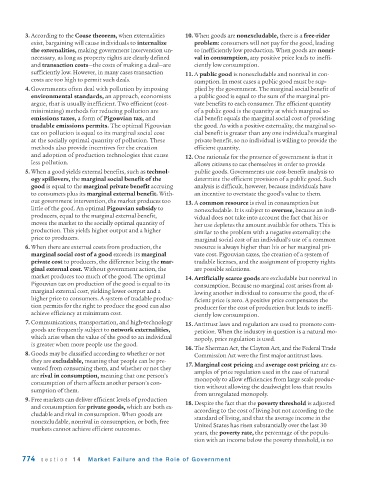Page 816 - Krugmans Economics for AP Text Book_Neat
P. 816
3. According to the Coase theorem, when externalities 10. When goods are nonexcludable, there is a free-rider
exist, bargaining will cause individuals to internalize problem: consumers will not pay for the good, leading
the externalities, making government intervention un- to inefficiently low production. When goods are nonri-
necessary, as long as property rights are clearly defined val in consumption, any positive price leads to ineffi-
and transaction costs—the costs of making a deal—are ciently low consumption.
sufficiently low. However, in many cases transaction 11. A public good is nonexcludable and nonrival in con-
costs are too high to permit such deals. sumption. In most cases a public good must be sup-
4. Governments often deal with pollution by imposing plied by the government. The marginal social benefit of
environmental standards, an approach, economists a public good is equal to the sum of the marginal pri-
argue, that is usually inefficient. Two efficient (cost- vate benefits to each consumer. The efficient quantity
minimizing) methods for reducing pollution are of a public good is the quantity at which marginal so-
emissions taxes, a form of Pigouvian tax, and cial benefit equals the marginal social cost of providing
tradable emissions permits. The optimal Pigouvian the good. As with a positive externality, the marginal so-
tax on pollution is equal to its marginal social cost cial benefit is greater than any one individual’s marginal
at the socially optimal quantity of pollution. These private benefit, so no individual is willing to provide the
methods also provide incentives for the creation efficient quantity.
and adoption of production technologies that cause 12. One rationale for the presence of government is that it
less pollution. allows citizens to tax themselves in order to provide
5. When a good yields external benefits, such as technol- public goods. Governments use cost-benefit analysis to
ogy spillovers, the marginal social benefit of the determine the efficient provision of a public good. Such
good is equal to the marginal private benefit accruing analysis is difficult, however, because individuals have
to consumers plus its marginal external benefit. With- an incentive to overstate the good’s value to them.
out government intervention, the market produces too 13. A common resource is rival in consumption but
little of the good. An optimal Pigouvian subsidy to nonexcludable. It is subject to overuse, because an indi-
producers, equal to the marginal external benefit, vidual does not take into account the fact that his or
moves the market to the socially optimal quantity of her use depletes the amount available for others. This is
production. This yields higher output and a higher similar to the problem with a negative externality: the
price to producers. marginal social cost of an individual’s use of a common
6. When there are external costs from production, the resource is always higher than his or her marginal pri-
marginal social cost of a good exceeds its marginal vate cost. Pigouvian taxes, the creation of a system of
private cost to producers, the difference being the mar- tradable licenses, and the assignment of property rights
ginal external cost. Without government action, the are possible solutions.
market produces too much of the good. The optimal 14. Artificially scarce goods are excludable but nonrival in
Pigouvian tax on production of the good is equal to its consumption. Because no marginal cost arises from al-
marginal external cost, yielding lower output and a lowing another individual to consume the good, the ef-
higher price to consumers. A system of tradable produc- ficient price is zero. A positive price compensates the
tion permits for the right to produce the good can also producer for the cost of production but leads to ineffi-
achieve efficiency at minimum cost. ciently low consumption.
7. Communications, transportation, and high-technology 15. Antitrust laws and regulation are used to promote com-
goods are frequently subject to network externalities, petition. When the industry in question is a natural mo-
which arise when the value of the good to an individual nopoly, price regulation is used.
is greater when more people use the good.
16. The Sherman Act, the Clayton Act, and the Federal Trade
8. Goods may be classified according to whether or not Commission Act were the first major antitrust laws.
they are excludable, meaning that people can be pre-
17. Marginal cost pricing and average cost pricing are ex-
vented from consuming them, and whether or not they
amples of price regulation used in the case of natural
are rival in consumption, meaning that one person’s
monopoly to allow efficiencies from large scale produc-
consumption of them affects another person’s con-
tion without allowing the deadweight loss that results
sumption of them.
from unregulated monopoly.
9. Free markets can deliver efficient levels of production
18. Despite the fact that the poverty threshold is adjusted
and consumption for private goods, which are both ex-
according to the cost of living but not according to the
cludable and rival in consumption. When goods are
standard of living, and that the average income in the
nonexcludable, nonrival in consumption, or both, free
United States has risen substantially over the last 30
markets cannot achieve efficient outcomes.
years, the poverty rate, the percentage of the popula-
tion with an income below the poverty threshold, is no
774 section 14 Market Failure and the Role of Gover nment

